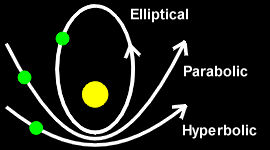One of the simplest ways of categorising comets is by their orbital period. In their most basic categorisation, they come in two flavours. Short period comets and long period comets.
Short Period Comets
Short period comets have an orbital period of less than 200 years. They also commonly have an inclination of less than 35 degrees. 200 years sounds like a long time period but in cometary terms, this is quite short. Once detected, they are more easy to catalogue and predict than long period comets. The most famous short period comet is Comet Halley with an orbital period of 75-76 years. It’s thought that short period comets originate from the Kuiper belt. Their designation is Short period comets are split in to two further categories namely Halley Type (with a period of over 20 years) and Jupiter Type (with a period of under 20 years). Short period comets may have a close to circular orbit or elliptical orbit. The latter being far more common.
Long Period Comets
Long period comets, on the other hand, are thought to originate from the Oort cloud with periods of over 200 years and at random inclinations around the celestial sphere. They can return after periods of thousands to millions of years (or not at all) and so they are difficult to detect and catalogue. Long period comets can have much more unpredictable orbits being randomly oriented on the celestial sphere. They can return on their steps after periods of thousands to millions of years (or not at all) and so they are difficult to detect and catalogue.
Non-returning long period comets can be categorised further. Their orbits can be parabolic or hyperbolic.
Parabolic Orbits
A parabolic orbit is when the object has just enough escape velocity (speed against gravitational pull) to escape its gravitational influence (i.e. our sun). They will never return to the solar system unless influenced by another object sometime in the future in such a way to do so. It’s for this reason that the object’s orbit is incapable of being circular or an ellipse.
Hyperbolic Orbits
A hyperbolic orbit is when the object accelerates considerably more past it’s escape velocity resulting in a much straighter path line than a parabolic orbit.
Below is an illustration of the orbits…

